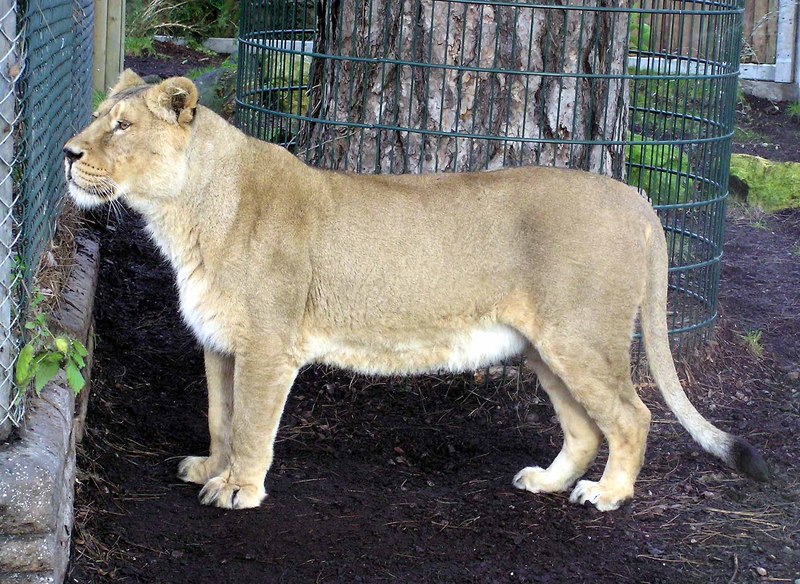Asiatic Lion (Panthera leo persica) - Wiki Asiatic Lion
From Wikipedia, the free encyclopedia
[Photo] Asiatic Lioness (Panthera leo persica), name MOTI, born Helsinki Zoo (Finland) in October 1994, arrived Bristol Zoo (England) in January 1996. Taken by Adrian Pingstone at Bristol Zoo, England, in January 2005 and released to the public domain.
The Asiatic Lion (Panthera leo persica) is a subspecies of lion. It is also known as the Indian Lion in India and even though it became recently extinct in Iran and elsewhere in middle east it is still called the Persian Lion in Iran.
The last remnants of the Asiatic Lion, which in historical times ranged from Caucasus to Yemen and from Macedon to present-day India through Ancient Pakistan and Iran (Persia), lives in the Gir Forest National Park of western India. About 359 lions (April 2006) live in a 1,412 km² (558 square miles) sanctuary in the state of Gujarat. In 1907 there were only 13 lions left in the Gir, when the Nawab of Junagadh gave complete protection to them.
Unlike the tiger, which prefers dense forests with adequate cover, the lion inhabits the scrub-type deciduous forests and open habitats. Today wild lions do not come into contact with the tiger which also lives in India, because the striped cat does not occur in the Gir region.
Fact-sheet
Compared to its African counterpart, the males of the Indian lion have a scantier mane and a characteristic skin fold at the belly.
- Weight: Male 150-225 Kg; Female 120-160 Kg
- Length (head and body): Male 170-250 cm; Female 140-175 cm
- Length (tail): 70-105 cm
- Shoulder height: Male 100-123 cm; Female 80-107 cm
- Sexual Maturity: Male 5 years; Female 4 years
- Mating season: All year round
- Gestation period: 100-119 days
- Number of young: 1 to 6
- Birth interval: 18-26 months
- Typical diet: Deer, antelope, wild boar, buffalo
- Lifespan: 16-18 years
Other Names/ Vernacular names
Indian Lion (English);
Iranian / Persian Lion (English);
Singh, Shinh / Sinh, Simha, babbar sher, untia bagh [camel tiger] (Hindi);
sinh, sawaj (Gujarati);
hawaj (Maldhari);
babbar sher (Urdu);
shir (Persian);
lion d’Asie (French);
Asiatischer L??we (German);
le??n de Asia (Spanish);
le??o asi??tico (Portuguese)
Asiatic Lions in Europe
Lions used to live in historic times also in Europe. Aristotle and Herodotus wrote that lions were found in the Balkans in the middle of the first millennium B.C. When Xerxes advanced through Macedon in 480 B.C., several of his baggage camels were killed by lions. Lions are believed to have died out within the borders of present-day Greece in A.D. 80-100. The european population is generally considered part of the Asiatic lion (Panthera leo persica) group, but others consider it a separate subspecies, the European lion (Panthera leo europaea).
There was also a population of the Asiatic Lion in the Caucasus mountains, which was the northernmost point of the lion range until they become extinct in the area. These lions become extinct from Armenia around the year 300 and from Azerbaijan and southwest Russia during the 10th century. In this area the lion coexisted with other Big Cats like the Caspian tiger (which survived in Caucasus until the 1920s), the Caucasian leopard and the Asiatic Cheetah, and they prey in Caucasus included the Caucasian Wisent, Caucasian Elk, aurochs, tarpan and others ungulates. It remained widespread elsewhere until the mid-1800s when the advent of firearms led to its extinction over large areas. (Guggisberg 1961) By the late 1800s the lion had disappeared from Turkey (Ustay 1990).[1] The last sighting of a live Asiatic Lion in Iran was in 1941 (between Shiraz and Jahrom, Fars province). In 1944, the corpse of a lioness was sighted on the banks of Karun river, Khuzestan province, Iran. There are no reliable reports from Iran after these dates.
History in Caucasia
Historically, the Caucasus was inhabited by three big cats: Asiatic lion,Caspian tiger, and Persian leopard. Moreover, until 15 A.D. the Armenian princes imported the Asiatic cheetahs (Acinonyx jubatus venaticus), tamed them, and used in high-rank hunts. The lion disappeared here in about 10 A.D. and the last tiger was shot in 1932 near Prishib village in Talis, Azerbaijan. The principal reasons of their disappearance were extermination of predators and their prey and habitat destruction. Later, this tiger subspecies had vanished forever and the Asiatic lion is confined now to a single population in west India. The leopard has outlived them all, but can be wiped out if the authorities at all levels do not express more political will and support.
"Barbary Lion", a North African relative
In 1968, a study on the skulls of the extinct Barbary (North African), extinct Cape, Asiatic, and African lions showed that the same skull characteristics - the very narrow postorbital bar - existed in only the Barbary and the Asiatic lion skulls. This shows that there may have been a close relationship between the lions from Northernmost Africa and Asia. It is also believed that the South European lion that became extinct at the beginning in A.D. 80-100, could have represented the connecting link between the North African and Asiatic lions. It is believed that Barbary lions possessed the same belly fold (hidden under their manes) that appears in the Asian lions today.
http://en.wikipedia.org/wiki/Asiatic_Lion
| The text in this page is based on the copyrighted Wikipedia article shown in above URL. It is used under the GNU Free Documentation License. You may redistribute it, verbatim or modified, providing that you comply with the terms of the GFDL. |
